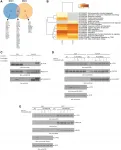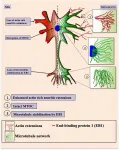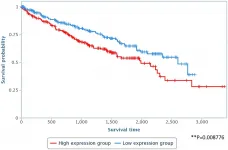(Press-News.org) The ubiquitous overuse injuries that nag runners may stem from an unlikely culprit: how far you lean forward.
Trunk flexion, the angle at which a runner bends forward from the hip, can range wildly--runners have self-reported angles of approximately -2 degrees to upward of 25. A new study from the END
Want to avoid running overuse injuries? Don't lean forward so much, says CU Denver study
Researchers found that greater trunk flexion has significant impact on stride length, joint movements, and ground reaction forces
2021-07-12
ELSE PRESS RELEASES FROM THIS DATE:
Heart risk 'calculators' overlook increased risk for people of South Asian ancestry
2021-07-12
DALLAS, July 12, 2021 -- People of South Asian ancestry have more than double the risk of developing heart disease compared to people of European ancestry, yet clinical risk assessment calculators used to guide decisions about preventing or treating heart disease may fail to account for the increased risk, according to new research published today in the American Heart Association's flagship journal Circulation.
About a quarter of the world's population (1.8 billion people) are of South Asian descent, and prior research has shown South Asians experience higher rates of heart disease compared to people of most other ethnicities.
To better understand the variables surrounding the heart disease risk for people of South Asian ancestry, researchers evaluated ...
Innovative gene therapy 'reprograms' cells to reverse neurological deficiencies
2021-07-12
A novel method of gene therapy is helping children born with a rare genetic disorder called AADC deficiency that causes severe physical and developmental disabilities. The study, led by researchers at The Ohio State University Wexner Medical Center and The Ohio State University College of Medicine, offers new hope to those living with incurable genetic and neurodegenerative diseases.
Research findings are published online in the journal Nature Communications.
This study describes the findings from the targeted delivery of gene therapy to midbrain to treat a rare ...
USC researchers discover better way to identify DNA variants
2021-07-12
USC researchers have achieved a better way to identify elusive DNA variants responsible for genetic changes affecting cell functions and diseases.
Using computational biology tools, scientists at the university's Dornsife College of Letters, Arts and Sciences studied "variable-number tandem repeats" (VNTR) in DNA. VNTRs are stretches of DNA made of a short pattern of nucleotides repeated over and over, like a plaid pattern shirt. Though they comprise but 3% of the human genome, the repetitive DNA governs how some genes are encoded and levels of proteins are produced in a cell, and account for most of the structural variation.
Current methods do not accurately detect the variations in genes in some repetitive ...
Scientists blueprint bacterial enzyme believed to "stealthily" suppress immune response
2021-07-12
Scientists have produced the first fine-detail molecular blueprints of a bacterial enzyme known as Lit, which is suspected to play a "stealthy" role in the progression of infection by reducing the immune response.
Blueprints such as these allow drug designers to uncover potential weaknesses in bacterial arsenals as they seek to develop new therapeutics that may help us win the war against antibiotic resistance.
The study, led by scientists from the School of Biochemistry and Immunology and the Trinity Biomedical Sciences Institute (TBSI) at Trinity College Dublin, has just been published by leading international journal Nature Communications.
Lipoproteins and their role in ...
A Trojan horse could help get drugs past our brain's tough border patrol
2021-07-12
Sclerosis, Parkinson's Disease, Alzheimer's and epilepsy are but a few of the central nervous system disorders. They are also very difficult to treat, since the brain is protected by the blood-brain barrier.
The blood-brain barrier works as a border wall between the blood and the brain, allowing just certain molecules to enter the brain. And whereas water and oxygen can get through, as can other substances such as alcohol and coffee. But it does block more than 99 percent of potentially neuroprotective compounds from reaching their targets in the brain.
Now, ...
Just 25 mega-cities produce 52% of the world's urban greenhouse gas emissions
2021-07-12
In 2015, 170 countries worldwide adopted the Paris Agreement, with the goal limiting the average global temperature increase to 1.5°C. Following the agreement, many countries and cities proposed targets for greenhouse gas mitigation. However, the UNEP Emissions Gap Report 2020 shows that, without drastic and strict actions to mitigate the climate crisis, we are still heading for a temperature increase of more than 3°C by the end of the 21st century.
A new study published in the journal Frontiers in Sustainable Cities presents the first global balance sheet of greenhouse gasses (GHGs) emitted by major cities around the world. The aim was to research and monitor the effectiveness of historical GHG reduction ...
Addressing social needs may help mitigate distress and improve the health of women with cancer
2021-07-12
A new study published by Wiley early online in CANCER, a peer-reviewed journal of the American Cancer Society, has identified unmet social needs in women with gynecologic cancer that could be addressed to improve care for patients and lessen disparities. For example, identifying patients who reported needing help with reading hospital materials resulted in the use of a cancer care navigator who provided patient education and support, facilitating physician-patient communication and adherence to care recommendations.
The prospective survey-based ...
Oncotarget: Inhibitory effects of Tomivosertib in acute myeloid leukemia
2021-07-12
Oncotarget published "Inhibitory effects of Tomivosertib in acute myeloid leukemia" which reported that the authors evaluated the therapeutic potential of the highly-selective MNK1/2 inhibitor Tomivosertib on AML cells.
Tomivosertib was highly effective at blocking eIF4E phosphorylation on serine 209 in AML cells.
Moreover, combination of Tomivosertib and Venetoclax resulted in synergistic anti-leukemic responses in AML cell lines.
Mass spectrometry studies identified novel putative MNK1/2 interactors, while in parallel studies we demonstrated that MNK2 - RAPTOR - mTOR complexes are not disrupted by Tomivosertib.
Overall, these Oncotarget findings demonstrate that Tomivosertib exhibits potent ...
Oncotarget: Modulating Tau Post-translational modifications and cytoskeletal network
2021-07-12
Oncotarget published "Epigallocatechin-3-gallate modulates Tau Post-translational modifications and cytoskeletal network" which reported that the chemical modulators of Tau PTMs, such as kinase inhibitors and antibody-based therapeutics, have been developed, but natural compounds, as modulators of Tau PTMs are not much explored.
These authors applied biophysical and biochemical techniques like fluorescence kinetics, oligomerization analysis and transmission electron microscopy to investigate the impact of EGCG on Tau glycation in vitro.
EGCG inhibited methyl glyoxal -induced Tau glycation in vitro.
EGCG potently inhibited MG-induced advanced glycation endproducts formation in neuroblastoma cells as well modulated the localization ...
Oncotarget: LAPAS1 is required for S phase progression and cell proliferation
2021-07-12
Oncotarget published "A novel E2F1-regulated lncRNA, LAPAS1, is required for S phase progression and cell proliferation" which reported that long non-coding RNAs are major regulators of many cellular processes, including cell cycle progression and cell proliferation.
Inhibition of LAPAS1 expression increases the percentage of S phase cells, and its silencing in synchronized cells delays their progression through S phase.
In agreement with its suggested role in cell cycle progression, prolonged inhibition of LAPAS1 attenuates proliferation of human cancer cells.
Importantly, knockdown of SPNS2 rescues the effect of LAPAS1 silencing on cell cycle ...
LAST 30 PRESS RELEASES:
Making lighter work of calculating fluid and heat flow
Normalizing blood sugar can halve heart attack risk
Lowering blood sugar cuts heart attack risk in people with prediabetes
Study links genetic variants to risk of blinding eye disease in premature infants
Non-opioid ‘pain sponge’ therapy halts cartilage degeneration and relieves chronic pain
AI can pick up cultural values by mimicking how kids learn
China’s ecological redlines offer fast track to 30 x 30 global conservation goal
Invisible indoor threats: emerging household contaminants and their growing risks to human health
Adding antibody treatment to chemo boosts outcomes for children with rare cancer
Germline pathogenic variants among women without a history of breast cancer
Tanning beds triple melanoma risk, potentially causing broad DNA damage
Unique bond identified as key to viral infection speed
Indoor tanning makes youthful skin much older on a genetic level
Mouse model sheds new light on the causes and potential solutions to human GI problems linked to muscular dystrophy
The Journal of Nuclear Medicine ahead-of-print tip sheet: December 12, 2025
Smarter tools for peering into the microscopic world
Applications open for funding to conduct research in the Kinsey Institute archives
Global measure underestimates the severity of food insecurity
Child survivors of critical illness are missing out on timely follow up care
Risk-based vs annual breast cancer screening / the WISDOM randomized clinical trial
University of Toronto launches Electric Vehicle Innovation Ontario to accelerate advanced EV technologies and build Canada’s innovation advantage
Early relapse predicts poor outcomes in aggressive blood cancer
American College of Lifestyle Medicine applauds two CMS models aligned with lifestyle medicine practice and reimbursement
Clinical trial finds cannabis use not a barrier to quitting nicotine vaping
Supplemental nutrition assistance program policies and food insecurity
Switching immune cells to “night mode” could limit damage after a heart attack, study suggests
URI-based Global RIghts Project report spotlights continued troubling trends in worldwide inhumane treatment
Neutrophils are less aggressive at night, explaining why nighttime heart attacks cause less damage than daytime events
Menopausal hormone therapy may not pose breast cancer risk for women with BRCA mutations
Mobile health tool may improve quality of life for adolescent and young adult breast cancer survivors
[Press-News.org] Want to avoid running overuse injuries? Don't lean forward so much, says CU Denver studyResearchers found that greater trunk flexion has significant impact on stride length, joint movements, and ground reaction forces


